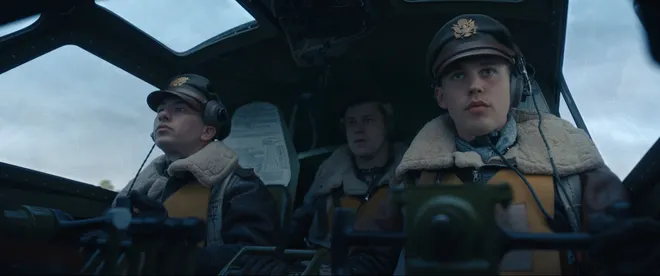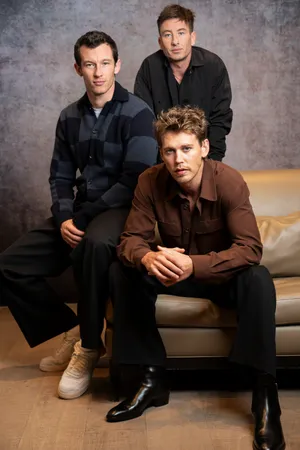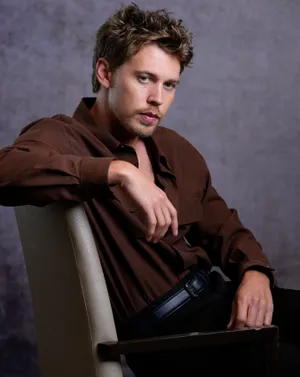In 'Masters of the Air,' Austin Butler, Barry Keoghan and cast formed real friendships
Ask Callum Turner why he was cast as Maj. John Egan, a real-life bomber pilot in the new Apple TV+ World War II series “Masters of the Air” (first two episodes streaming Friday, then weekly), and he just laughs.
“I think I just have the right hair for the period. It’s always the hair,” says Turner, 33, an Englishman who, for the second time of late, is playing an American hero from nearly a century ago (he was Joe Rantz in the 1930s rowing drama “The Boys in the Boat”).
Sorry, Callum. It’s far more than the close-cropped hair. It’s the baked-in heroism.
“Masters” required actors who could conjure a mixture of bravado, vulnerability, patriotism and camaraderie. Turner, along with Austin Butler, Barry Keoghan and a cast of 300, summoned those attributes while living for nearly a year in a physical and virtual re-creation of hell on earth in the English countryside.

The production’s size and scope rivaled that of a small war.
“We hope it’s all there on the screen,” says executive producer Gary Goetzman of the $250 million budget for “Masters,” who shares producing credits with Tom Hanks and Steven Spielberg in this latest chapter in the trio’s HBO Greatest Generation tributes, 2001’s “Band of Brothers” and 2010’s “The Pacific.”
“Masters of the Air” is a nine-part series that chronicles the real 1943 exploits of the 100TH Bomber Group (based on Donald L. Miller’s 2006 book): Men in their teens and early 20s who paved the way for the ground invasion of Europe by Allied forces through missions that bordered on the suicidal.
“It all started back when Steven’s father, who was on missions (in the Army Air Corps) during the war, saw ‘Band of Brothers,’ and he asked him, ‘When are you telling the pilots’ stories?’” says Goetzman. “We said, 'Let’s tackle it.' But it’s taken us years. Finally, the technology was there.”
Austin Butler describes the 'joy and the fear' of World War II fighter pilots
What Goetzman means is that while the “Masters” set included acres of real barracks filled with nuanced details, the series wouldn't work without credible air battle sequences.

Thanks to accurate and quick digital renderings of hundreds of B-17 Flying Fortress bombers and P-51 Mustang fighter planes, viewers are a solid surround-sound system away from feeling like they’re on harrowing mission with the boys.
“Talking to some of the few pilots who remain from the 100TH, who are over 100 years old, the main thing they talk about is the fear,” says Butler, 32 ("Elvis"), who personifies cool under pressure as Maj. Gale “Buck” Cleven.
“You think about what that must have been like, flying on missions where 77% of you would not make it back to base in one piece because you either died or were downed,” he says. “How we got to film it was a gift, because you really sensed the joy and the fear.”
The joy came from being part of a village that was largely locked down for a 10-month shoot during the height of the pandemic. Wandering the 100TH’s fictitious base, actors would see newspapers and posters from the period that allowed for total immersion.
“There were people doing marching drills and you’d look and there wasn’t even a camera on them. Or you’d open up some random desk drawer and see love letters or mission orders,” says Keoghan, 31 ("Saltburn"), who plays Lt. Curtis Biddick with a let’s-just-get-the-job-done ease.
“What really struck me was how little training and technology those lads had compared to today,” he says.
High-tech filmmaking meant 'Masters' stars didn't have to fake the fear
In fact, technology is what helped Keoghan and his soldier brothers fully get into character. While air battles were executed digitally, the production used four real B-17s, and full-scale mock-ups of cockpits and bomber bays that were suspended 50 feet in the air on a gimbal and surrounded by high-definition screens.

The result was an almost nauseating realism, says Turner.
“There were 32 cameras shooting you from all angles, and the screens made you believe you were in the air,” he says. “And if the plane was going down in the scene, or if flak hit you, that cockpit dove and shook, so in that respect, as an actor there was nothing to fake.”
Butler has the same vivid memories. “You’d look out at the screens below you, and it was almost like you actually were flying over Greenland for real,” he says.
“Masters” makes plain to viewers what sort of courage was required to jump into uninsulated planes that flew, often unescorted, in daylight into enemy territory. For its cast, the fuel that made all that possible for the real 100TH fliers was an indelible web of friendships forged in the cauldron of battle, friendships that echoed on the set.
“That experience created a brotherhood, really, and it’s an experience that I hold dear to my heart to this day,” says Keoghan.

Austin Butler says filming 'Masters' has turned co-star Callum Turner into a lifelong friend
For Butler and Turner, it goes one step further. The two say they now share a friendship rivaled perhaps only by that of the real Cleven and Egan.
“He’s so brilliant,” Turner says of Butler. “He was the yin to my yang. And there’s no judgment with him.”
Butler is blunt: “Callum is one of my best friends in the world right now, I have so much respect for him as he’s a lot like that guy (in “Masters”): very positive, a natural leader,” he says.
Both actors shared a similar source of inspiration on “Masters.” Each thought of their grandfathers. In Butler’s stoic Clevens, "that super precise guy who didn’t smoke or drink and who all the younger guys wanted to be, that reminded me of my grandfather.”

In Turner’s, the parallel to Egan is more direct. “My grandfather left home at 16 (to join British forces), tricking his mother into signing something that said he was going on a school trip. He wound up in a prisoner of war camp in Italy.”Turner pauses and runs a hand through his short hair.
“Where did they find that courage? I mean today, you can’t get on Wi-Fi and you feel you’re life’s over,” he says. “I get emotional thinking about it. I just hope I’d have the guts to do what my grandfather and so many others did, all pulling in the same direction just so we – you and me – could have the future that we have. To me, they were superheroes.”

Disclaimer: The copyright of this article belongs to the original author. Reposting this article is solely for the purpose of information dissemination and does not constitute any investment advice. If there is any infringement, please contact us immediately. We will make corrections or deletions as necessary. Thank you.







